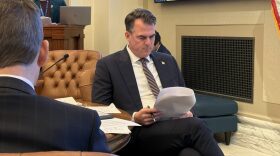After last year’s deadly tornadoes, private insurers paid out over $1 billion in claims. FEMA also chipped in $15 million as part of its individual and household assistance program. But nearly three-quarters of that program’s applicants were denied.
As part of our series tracking the federal aid money, we look at the decision-making process that left much of Central Oklahoma out of luck.
On the evening of May 20th, 2013, James and Sheryl Pennington stepped outside their home in Moore to find debris everywhere. The tornado had left a devastating trail, and they weren’t exempt from its destruction.
“The front door was blown out. We had the roof and windows and some inside damage. The roof leaked the next day. I think it started raining, and we had water pouring into the kitchen.”
It was a bad situation, but other families in the city had it even worse.
“The whole house was gone except for the bathroom we would've been in if we had stayed,” said Susan Montesano.
She and her fiancé were living in a rental home with their two young kids, Braden and Aspen, at the time of the tornado.
“There was a tree that had fell in on the kids’ bedroom, which was in our front yard. Our kitchen kind of fell on itself. Our garage was gone; our living room was gone; our couches were gone,” Montesano said.
Friends urged her to apply for FEMA assistance, but she wasn’t very hopeful.

“We didn't have renters' insurance so they're probably going to be like, 'Well you didn't have renters' insurance, so we’re not going to help you out.’”
Meanwhile, James and Sheryl Pennington did have insurance. It paid out enough for them start repairs, but not enough to finish the job. James assumed this was where the government aid would kick in.
“I thought FEMA was gonna help us a little, and I thought, ‘Man, that's great!’”
Both families were among the more than 15,000 Oklahomans who applied for FEMA individual assistance. But only one-quarter of the state’s residents were deemed eligible.
Susan Montesano was one of them. She received nearly $15,000 in assistance. That’s substantial, especially when the average amount awarded statewide was just over $4,000.
“Because of FEMA, my daughter got a bed, a real bed. We got to get a new crib for Braden, and they got their own little sheets kind of like what they had before, and it's just nice to be able to make things back to the way it was supposed to be if it hadn't happened,” she said.
But the Penningtons weren’t as lucky. They were denied because they had homeowners’ insurance, even though it fell short of covering all their damages.
Keli Cain with the Oklahoma Department of Emergency Management says that’s the way the system is designed.
“If you have insurance on your property, if your property or your belongings are going to be replaced through insurance, then you're not going to qualify for that FEMA assistance as well.”
Cain says the federal government wants to make sure it doesn’t duplicate aid homeowners receive from other sources. Still, after the storm, she and other state officials urged all residents to apply, even if they didn’t think they’d be eligible.
Some people who were underinsured did end up getting FEMA aid after all. But Sheryl Pennington says that in her case, she got her hopes up, only to let her down in the end.
“People kept coming by insisting on me to pursue the FEMA thing like it was going to turn out to our benefit, but it was just a waste of time.”
Without enough funding to hire contractors to finish repairs, James is doing the work himself, in his free time. He hopes to finish by the end of the year, but it’s been challenging and slow-going.
It’s a hard lesson survivors of other disasters have also had to learn: that the safety nets they thought would be there to help, sometimes aren’t, so getting back on your feet and returning to normal life can be a difficult process.
-----
Oklahoma Watch is a nonprofit, nonpartisan media service that produces in-depth and investigative journalism on public-policy issues facing the state. For more Oklahoma Watch content, go to www.oklahomawatch.org. The data team for Investigative Reporters and Editors and the Investigative News Network assisted with the project.
The Oklahoma Tornado Project is made possible by a grant from the Corporation for Public Broadcasting.
As a community-supported news organization, KGOU relies on contributions from readers and listeners to fulfill its mission of public service to Oklahoma and beyond. Donate online, or by contacting our Membership department.








